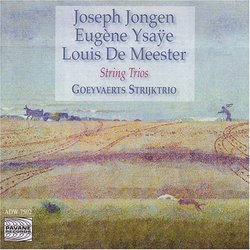| All Artists: Joseph Jongen, Eugene Ysaye, Louis de Meester, Goeyvaerts Strijktrio Title: Joseph Jongen, Eugène Ysaÿe, Louis De Meester: String Trios Members Wishing: 0 Total Copies: 0 Label: Pavane Original Release Date: 1/1/2006 Re-Release Date: 9/26/2006 Album Type: Import Genre: Classical Styles: Chamber Music, Historical Periods, Classical (c.1770-1830) Number of Discs: 1 SwapaCD Credits: 1 UPCs: 675754933227, 5410939750221 |
Search - Joseph Jongen, Eugene Ysaye, Louis de Meester :: Joseph Jongen, Eugène Ysaÿe, Louis De Meester: String Trios
 | Joseph Jongen, Eugene Ysaye, Louis de Meester Joseph Jongen, Eugène Ysaÿe, Louis De Meester: String Trios Genre: Classical
|
Larger Image |
CD Details |
CD ReviewsTHREE by THREE by THREE Dace Gisclard | Houston, TX | 03/21/2009 (5 out of 5 stars) "That is, three well-contrasted trios by three interesting Belgian composers performed by three fine players... The program has a pleasing balance of styles--one work each in early impressionist, late romantic, and atonal(?) idioms.
Jongen is probably best known to modern audiences through the technicolor spectacular of his Symphonie Concertante for organ and orchestra. His impressionist-influenced Trio of 1948 is one of his finest later works--indeed, one of his finest, period. It serves as an enticing appetizer before the Ysaye. Modal and whole-tone scales permeate both melody and harmony. From the beginning, it's pretty obvious Jongen had been listening to Bach. A witty transformation of the opening motif of Brandenburg No.3 begins the exposition. This never descends into pastiche, and dovetails convincingly into the whole-tone harmonies and ninth chords of the second subject. The movement revolves about this witty interplay. A sweetly pensive meditation on modal melodies serves as slow movement. The sinister and the cheerful alternate in the whole-tone harmonies of the scherzo. In the finale, dance-like rhythms and bright harmonies glow with a luminosity that will be familiar to those who love his Symphonie Concertante. Ysaye is the late romantic among these cats, and his is the weightiest work on the disc. Today, he is best known for his Six Sonatas for Solo Violin, Op.27 of 1923--required listening for anyone intrigued by the warring "modernist" and conservative tendencies of the early 20th century. Although composed in 1927, the Trio had to wait 57 years for its public premiere in 1964! According to the entertaining and informative notes by Rudy Tambuyser, the "Le Chimay" of the subtitle is "the residence of the princes of Chimay, who in the nineteenth century played a prominent role in the Belgian and international music world." As a performer, Ysaye reconciled the opposing heritages of the Apollonian Joachim and the Dionysian Sarasate. Similarly, his Trio is a selective balancing act with opposing trends encountered and assimilated into his personality over a lifetime as performer and composer. Being Belgian, he could not escape Franck's chromaticism, but he goes far beyond it. Certain passages strain the limits of tonality in the manner of D'Indy and Wagner. Debussy and Dukas are acknowledged with whole-tone gestures. As in the solo sonatas, highly charged emotionalism mingles with Bachian rigor, somewhat in the manner of his contemporary, Busoni. Perhaps the best stabs I can make at quick descriptions of Ysaye's idiom is either "Romantic-expressionist-neoclassic" (whew!), OR, more vividly, "Franck on caffeine laced with Bach". There's no one quite like him. Until now, I had never heard a single note of Louis de Meester's music. While I can't say that his 1951 Trio sets me athirst for more, the work is ingratiatingly lyrical and humorous--qualities not usually associated with atonality. Actually it's not entirely atonal. Although much of it sounds dodecaphonic, it is not merely acrid chains of dissonance. De Meester doesn't shrink from bittersweet consonances when they serve him. Also, there's a good feeling for tragi-comic timing and contrasts of texture at work here, and the Trio is brief enough to not outstay its welcome. In the first two movements, dance-like rhythms alternate with languid glissandi and tone clusters. The finale opens with Stravinskian repeated note ostinati and glassy ponticelli, enlivened with dance rhythms. Somehow, I'm reminded of the child-like wit of Paul Klee. The excellent musicians of the Goeyvaerts Trio (named for Belgian composer Karel Goeyvaerts) play with minimal vibrato. This can exaggerate every flaw of intonation, but luckily, theirs is pretty reliable. Their Jongen and Ysaye are warmly recommended to lovers of Franck, Chausson, D'Indy and the like. Their de Meester is for those who enjoy a 20th-century adventure with a sense of humor. Grand merci, messieurs!" |

 Track Listings (8) - Disc #1
Track Listings (8) - Disc #1